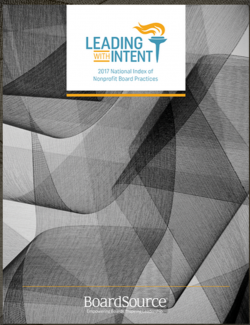Sep
13
2017

Earlier this week, BoardSource released Leading with Intent: 2017 National Index of Nonprofit Board Practices. BoardSource provides nonprofit leaders with tools, resources, and research to increase board effectiveness and strengthen organizational impact. Leading with Intent 2017 is the ninth in their series of reports focusing on nonprofit board composition, practices, performance, and culture. This new report reiterates key findings from BMP’s Race to Lead report and points to the ongoing need to target those governing nonprofit organizations to challenge the norms and assumptions that perpetuate the racial leadership gap.
Overall, BoardSource’s findings on key questions about diversity have remained the same from year to year…or gotten worse. For instance, a full 27% of all organizations that responded reported that their boards have zero people of color on the board—up from 25% two years ago. Additionally, 90% of CEOs and 84% of board members were white—up from 89% and 80% two years ago. Just as important as the concern about representation, the results also show ambivalence about taking action to address the fundamental problem. For example, larger shares of CEOs and board chairs were concerned/dissatisfied about lack of diversity, but only one-quarter ranked demographics as a high priority in board recruitment (Pg 13-4).
The data from Leading with Intent parallels many of our own survey findings about why there has a lack of progress on diversity in the sector. The Race to Lead data tells us that the majority of respondents (80%) think it’s a problem that nonprofit leadership doesn’t represent diversity of the U.S. but respondents were evenly split on whether their organizations paid enough attention to racial / ethnic diversity when recruiting new board members (Figure 20) . Additionally, Race to Lead respondents recognized Boards as a key barrier to career advancement for leaders of color, second only to executive recruiters, who aren’t equipped to challenge boards to confront their own biases anyway (Figure 19).
The results of this new study, supported and augmented by findings from Race to Lead, point to the need to challenge the biases, inaction and ambivalence that are too common among organizational boards and executive leaders. Those in influential and powerful positions in the sector – like board members and CEOs – should make addressing race and race equity a top priority in their work, including speaking out on how the sector should and can change its track record on race. In addition to changing the narrative about the problem, organizational structures, policies, and practices must also shift to make a real difference. There are lots of interventions that organizations can make, whether by really talking about the underlying issues of racial inequality with staff, developing and committing to a diversity plan, blinding the names and other identifying information about candidates when reviewing resumes, or working with consultants and recruiting firms with a demonstrated track-record of progress on racial equity. BoardSource also offers resources that may provide organizations and their leaders with additional tools and ideas for deconstructing the racial leadership gap. By changing the narrative, culture, and practices through research-based action, the sector can start moving the dial toward having measurable results that reflect our values of diversity, inclusion, and equity.
